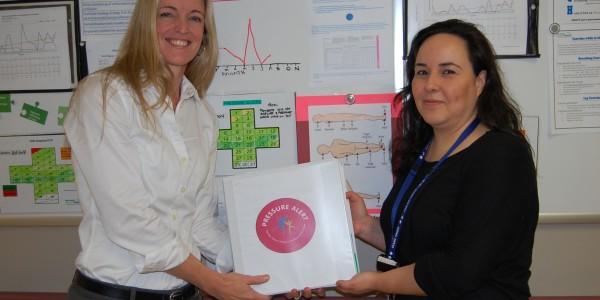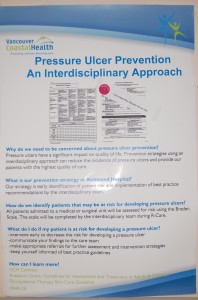Pressure ulcer screening and prevention goes from 0 to 100 at Richmond Hospital
Cutting edge work to assess a patient’s risk of developing a pressure ulcer – and working to prevent it – is yet another example of how Richmond Hospital’s interdisciplinary team approach to care is improving patient outcomes.
Launched as an accreditation project at Richmond Hospital in 2013, Pressure Ulcer Prevention has grown to the point where it is now part of everyday workflow across all inpatient units at the hospital.
Externally, the new pressure ulcer reduction strategy will be highlighted in early 2015 at the BC Quality and Safety Council Regional Quality Forum, and is currently being shared across the region to include the Regional Interdisciplinary Skin and Wound Committee and Lions Gate Hospital working group.
“We know that pressure ulcers can significantly impact a person’s physical, emotional and psychosocial function,” said Maria Torres, a Wound, Ostomy Continence Nurse, one of two Richmond Hospital staff members who lead the work.
Added Torres’ project partner, Practice Initiatives Lead, Lisa Stewart: “We need to have a comprehensive and sustainable interdisciplinary strategy to prevent our patients from developing pressure ulcers.”
The intervention
Stewart and Torres developed and implemented a unique interdisciplinary team approach to pressure ulcer risk assessment and intervention. The core component of the strategy is completion of an initial risk screen (using the Braden scale), and collaboration related to appropriate interventions by the interdisciplinary team at daily rounds.
The rationale and benefits of the strategy include:
- Engagement and awareness of the interdisciplinary team
- Pressure ulcer prevention as part of the team’s standard work
- Utilization of health discipline expertise
Our success
Completion of pressure ulcer risk assessments was not formally identified on patient charts prior to work beginning in 2013. Although Torres and Stewart knew assessments were routine on some inpatient units, the frequency and consistency under which they were administered couldn’t be formally quantified.
“Essentially we began from a baseline of zero,” said Torres. “Now all units have risk assessment completion rates that hover at close to 100 per cent.”
Lessons learned
Stewart and Torres give full credit to the entire Richmond Hospital team for embracing the strategy – even though it differed greatly from existing practice — and inserting it into everyday workflow. OTs from all units became project champions, leading completion of the discussion at R-Care.
Some of the lessons learned along the way include:
- Importance of a clearly established end goal with a flexible process and input.
- Importance of leadership presence and use of PDSAs to promote a culture of change.
- Positive impact of embedding process into daily workflow to promote awareness and support sustainability.
“We began this project during accreditation which is a really busy time, but everyone really got behind it,” said Stewart. “There’s power in team, and the success of this project is absolute proof of that.”


